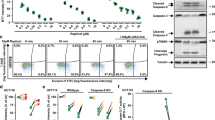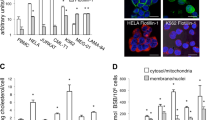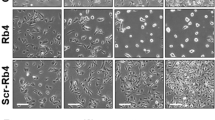Abstract
The small GTP-binding protein Rac is a downstream effector of the oncogene product p21-ras. Rac is involved in actin polymerization, Jun kinase activation, and intracellular superoxide anion production, through distinct pathways in tumor cells. Here we investigated the role of activated Rac in the response of tumor cells to apoptosis triggered by anti-cancer drugs or the cell surface death receptor CD95. Using M14 melanoma cells stably transfected with a constitutively active form of Rac1, we show that activated Rac inhibits tumor cell response to apoptosis. The inhibitory effect of activated Rac on apoptotic signaling is mediated by the interaction of Rac with intracellular oxidase and the subsequent production of superoxide, which is supported by experiments performed with M14 and NIH3T3 cells transiently transfected with the loss-of-function mutants of Rac in an activated RacV12 background. Consistent with these findings, we also demonstrate that inhibition of the Rac pathway in the HaRas-expressing T24 bladder carcinoma cell line induces a decrease in superoxide anion concentration, and results in a significant increase in tumor cell sensitivity to apoptosis. These findings demonstrate the existence of a novel Rac-dependent survival pathway mediated by intracellular superoxide in tumor cells.
This is a preview of subscription content, access via your institution
Access options
Subscribe to this journal
Receive 50 print issues and online access
$259.00 per year
only $5.18 per issue
Buy this article
- Purchase on Springer Link
- Instant access to full article PDF
Prices may be subject to local taxes which are calculated during checkout





Similar content being viewed by others
References
Boehm JE, Chaika OV, Lewis RE . 1999 J. Biol. Chem. 274: 28632–28636
Bos JL . 1988 Mutat. Res. 195: 255–271
Campbell SL, Khosravi-Far R, Rossman KL, Clark GJ, Der CJ . 1998 Oncogene 17: 1395–413
Capon DJ, Chen EY, Levinson AD, Seeburg PH, Goeddel DV . 1983 Nature 302: 33–37
Chandra J, Samali A, Orrenius S . 2000 Free Radic. Biol. Med. 29: 323–333
Clément MV, Pervaiz S . 1999 Free Radic. Res. 30: 247–252
Clément MV, Ponton A, Pervaiz S . 1998 FEBS Lett. 440: 13–18
Clément MV, Stamenkovic I . 1996 EMBO J. 15: 216–225
Dahlgren C, Karlsson A . 1999 J. Immunol. Methods 232: 3–14
Didsbury J, Weber RF, Bokoch GM, Evans T, Snyderman R . 1989 J. Biol. Chem. 264: 16378–16382
Downward J . 1990 Trends. Biochem. Sci. 15: 469–472
Downward J . 1998 Curr. Opin. Genet. Dev. 8: 49–54
Finkel T . 1999 J. Leukoc. Biol. 65: 337–340
Hirpara JL, Clément MV, Pervaiz S . 2001 J. Biol. Chem. 276: 514–521
Irani K, Goldschmidt-Clermont PJ . 1998 Biochem. Pharmacol. 55: 1339–1346
Irani K, Xia Y, Zweier JL, Sollott SJ, Der CJ, Fearon ER, Sundaresan M, Finkel T, Goldschmidt-Clermont PJ . 1997 Science 275: 1649–1652
Jacobson MD, Burne JF, King MP, Miyashita T, Reed JC, Raff MC . 1993 Nature 361: 365–369
Joneson T, Bar-Sagi D . 1998 J. Biol. Chem. 273: 17991–17994
Joneson T, Bar-Sagi D . 1999 Mol. Cell. Biol. 19: 5892–5901
Marte BM, Downward J . 1997 Trends. Biochem. Sci. 22: 355–358
Musleh W, Bruce A, Malfroy B, Baudry M . 1994 Neuropharmacology 33: 929–934
Pervaiz S, Hirpara JL, Clément MV . 1998 Cancer Lett. 128: 11–22
Pervaiz S, Ramalingan JK, Hirpara JK, Clément M-V . 1999a FEBS lett 343–348
Pervaiz S, Seyed MA, Hirpara JL, Clément MV, Loh KW . 1999b Blood 93: 4096–4108
Taparowsky E, Suard Y, Fasano O, Shimizu K, Goldfarb M, Wigler M . 1982 Nature 300: 762–765
Thornberry NA, Lazebnik Y . 1998 Science 281: 1312–1316
Toporik A, Gorzalczany Y, Hirshberg M, Pick E, Lotan O . 1998 Biochemistry 37: 7147–7156
Walker PR, Smith C, Youdale T, Leblanc J, Whitfield JF, Sikorska M . 1991 Cancer Res. 51: 1078–1085
Acknowledgements
The authors are very grateful to Dr Allan Hall, University College London, UK for the pEXVV12Rac and pEKVN17Rac, Dr Ofra Lotan, Sackler Faculty of Medicine, Tel Aviv University, Israel for the pGEX-2TRacH103A and pGEX-2TK166 and Dr Linda Van Aelst, Cold Spring Harbor laboratory, NY, USA for the pCGT RacV1240H and 37L mutants. We also thank Ms Shirani Sivarajah, Aaron Nicolas Seet and Koh Yi Ting for helpful technical assistance. This work was supported by grant R-364-000-013-213 from The National Medical Research Council, Singapore to M-V Clément.
Author information
Authors and Affiliations
Corresponding author
Rights and permissions
About this article
Cite this article
Pervaiz, S., Cao, J., Chao, O. et al. Activation of the RacGTPase inhibits apoptosis in human tumor cells. Oncogene 20, 6263–6268 (2001). https://doi.org/10.1038/sj.onc.1204840
Received:
Revised:
Accepted:
Published:
Issue Date:
DOI: https://doi.org/10.1038/sj.onc.1204840
Keywords
This article is cited by
-
Serum deprivation elevates the levels of microvesicles with different size distributions and selectively enriched proteins in human myeloma cells in vitro
Acta Pharmacologica Sinica (2014)
-
PKCα phosphorylation of RhoGDI2 at Ser31 disrupts interactions with Rac1 and decreases GDI activity
Oncogene (2013)
-
The faces and friends of RhoGDI2
Cancer and Metastasis Reviews (2012)
-
HBx Sensitizes Cells to Oxidative Stress-induced Apoptosis by Accelerating the Loss of Mcl-1 Protein via Caspase-3 Cascade
Molecular Cancer (2011)
-
Oxidative repression of NHE1 gene expression involves iron-mediated caspase activity
Cell Death & Differentiation (2007)



